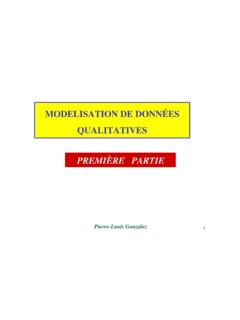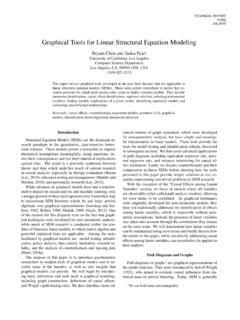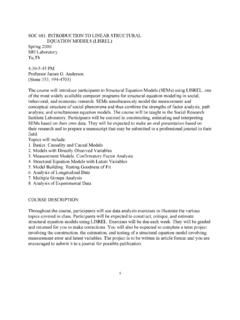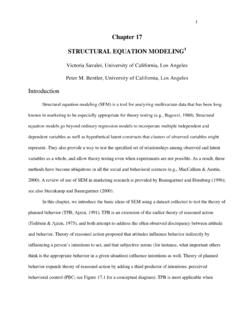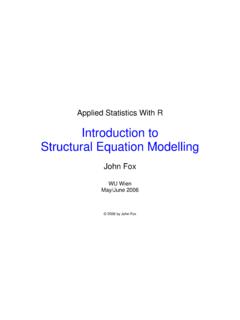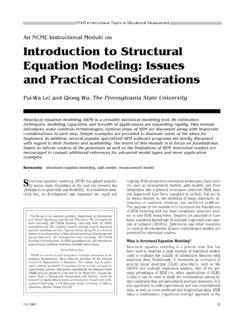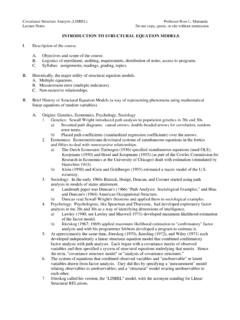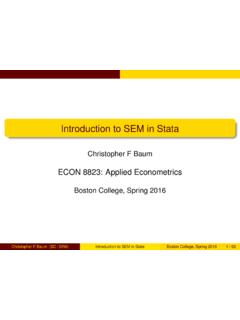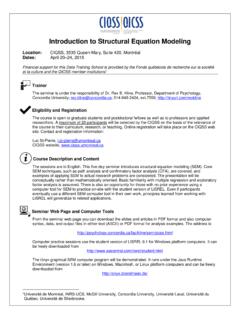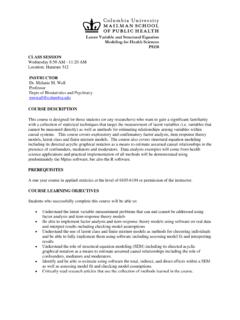Transcription of AN INTRODUCTION TO STRUCTURAL EQUATION MODELING
1 STA 201 Analyse Multivari e Approfondie AN INTRODUCTION TO STRUCTURAL EQUATION MODELING Giorgio 201 Analyse Multivari e Approfondie STRUCTURAL EQUATION Models (SEM) are complex models allowing us to study real world complexity by taking into account a whole number of causal relationships among latent concepts ( the Latent Variables, LVs), each measured by several observed indicators usually defined as Manifest Variables (MVs). Factor analysis, path analysis and regression are special cases of SEM. SEM is a largely confirmatory, rather than exploratory, technique. It is used more to determine whether a model is valid than to find a suitable model. But some exploratory elements are allowedKey concepts:Latent variables (unobservable by a direct way): abstract psychological variables like intelligence , attitude toward the brand , satisfaction , social status , ability , trust .Manifest variables are used to measure latent concepts and they contain sizable measurement errors to be taken into account: multiple measures are allowed to be associated with a single is recognized as difficult and error-prone: the measurement error is explicitly modeled seeking to derive unbiased estimates for the relationships between latent Russolillo slide 2 STRUCTURAL EQUATION MODELING (SEM) STA 201 Analyse Multivari e Approfondie STRUCTURAL EQUATION MODELING (SEM) G.
2 Russolillo slide 3 Several fields played a role in developing STRUCTURAL EQUATION Models : From Psychology, comes the belief that the measurement of a valid construct cannot rely on a single measure. From Economics comes the conviction that strong theoretical specification is necessary for the estimation of parameters. From Sociology comes the notion of ordering theoretical variables and decomposing types of 201 Analyse Multivari e Approfondie G. Russolillo slide 4 SEM: historical corner STA 201 Analyse Multivari e Approfondie Sewall Wright and Path Analysis Path Analysis aims to study cause-effect relations among several variables by looking to the correlation matrix among them. Sewall Wright (21 December 1889 3 Mars 1988)American Geneticist, son of the economist Philip Wright Path Analysis has been developed in the 20s by S. Wright to investigate genetic problems and to help his father in economic studies. The main newness is the INTRODUCTION of a new tool to investigate cause-effect relations: the path diagramG.
3 Russolillo slide 5 STA 201 Analyse Multivari e Approfondie Factor Analysis and the idea of Latent Variable Charles Edward Spearman (10 September 1863 17 September 1945)English psychologistC. Spearman proposed Factor Analysis (FA) at the begin of the 900s to measure intelligence in a objective most important input from Factor Analysis is the INTRODUCTION of the concept of factor (Latent Variable)The main idea is that the correlation observed among several indicators of intelligence should be explained by a unique underlying factor . G. Russolillo slide 6 STA 201 Analyse Multivari e Approfondie Thurstone and Multiple Factor Analysis Spearman approach has been modified in the following 40 years in order to considers more than one factor as cause of observed correlation among several set of manifest variablesLouis Thurstone (29 May 1887 30 September 1955)Psychologist, Psychometrician He is the father of the Multiple Factor Analysis.
4 In the 50 s he meets Herman Wold. They decide to co-organize the Upspsala Symposium on Psycological Factor Analysis . Herman Wold (25 december 1908 16 february 1992) Econometrician and StatisticianSince their meeting, H. Wold started working on Latent Variables Russolillo slide 7 STA 201 Analyse Multivari e Approfondie Causal models rediscovered Herbert Simon (June, 15 1916 February 9, 2001) Economist Nobel Prize for economic in 1978 In 1954 presents a paper proving that under certain assumptions correlation is an index of causality Hubert M. Blalock (23 Augut 1926 8 Febrary 1991) SociologistIn 1964 published the book Causal Inference in Nonexperimental Research , in which he defines methods able to make causal inference starting from the observed covariance matrix. He faces the problem of assessing relations among variables by means of the inferential developed the SIMON-BLALOCK techinqueG. Russolillo slide 8 STA 201 Analyse Multivari e Approfondie Path analysis and Causal models He has been one of the leading sociologists in the world.
5 He introduces the Path Analysis of Wright's in the mid-60's comes to the conclusion that there is no difference between the Path Analysis of Wright and the Simon-Blalock the economist Arthur Goldberger he comes to the conclusion that there is no difference between what was known in sociology as Path Analysis and simultaneous equations models commonly used in with Goldberger he organizes a conference in 1970 in Madison (USA) where he invited Karl J Russolillo slide 9 Otis D. Duncan (December, 2 1921 November, 16 2004)SociologistSTA 201 Analyse Multivari e Approfondie Covariance Structure Analysis and K. J reskog Karl J reskog Statistician, Professor at Uppsala University, SwedenAs a PhD student, in the late 50s he started working with Herman Wold. He discussed a thesis on Factor Analysis. In the second half of the 60s, he started collaborating with Duncan and A. Goldberger. This collaboration represents a meeting between Factor Analysis (and the concept of latent variable) and Path Analysis ( the idea behind causal models).
6 In 1970, at a conference organized by Duncan and Goldberger, J reskog presented the Covariance Structure Analysis (CSA) for estimating a linear STRUCTURAL EQUATION system, later known as LISRELG. Russolillo slide 10 STA 201 Analyse Multivari e Approfondie Soft MODELING and H. Wold In 1975, H. Wold extended the basic principles of an iterative algorithm aimed to the estimation of the PCs (NIPALS) to a more general procedure (PLS) for the estimation of relations among several blocks of variables linked by a network of relations specified by a path proposed the PLS Approach to estimate STRUCTURAL EQUATION Models (SEM) parameters, as a Soft MODELING alternative to J reskog's Covariance Structure AnalysisG. Russolillo slide 11 Herman Wold (December 25, 1908 February 16, 1992)Econometrician and StatisticianSTA 201 Analyse Multivari e Approfondie Path Analysis with manifest variables G.
7 Russolillo slide 12 STA 201 Analyse Multivari e Approfondie Path analysis: drawing conventions or or or Manifest Variables (VM) Unidirectional Path (cause-effect) Bidirectional Path (correlation) Feedback relation or reciprocal causation or or xxErrors G. Russolillo slide 13 STA 201 Analyse Multivari e Approfondie Drawing a regression model The multiple regression model (on centred variables) : y = 1x1 + 2x2 + can be drawn by using a Path Diagram:x1x2y Example: The Value for a brand in terms of Quality and CostThe error is an Unobserved / Latent variable Value, is an Observed / Manifest VariableQuality and Cost are Observed / Manifest Variables 2 1G. Russolillo slide 14 STA 201 Analyse Multivari e Approfondie Wright s path analysis G. Russolillo slide 15 STA 201 Analyse Multivari e Approfondie Path analysis: Wright s Tracing rules Tracing rules are a way to estimate the covariance between two variables by summing the appropriate connecting paths.
8 They are:1. Trace all paths between two variables (or a variable back to itself), multiplying all the coefficients along a given path2. You can start by going backwards along a single-headed arrow, but once you start going forward along these arrows you can no longer go backwards3. No loops. You cannot go through the same variable more that once for a given path4. At maximum, there can be one double-headed arrow included in a path5. After tracing all the paths for a given relationship, sum all the pathsG. Russolillo slide 16 STA 201 Analyse Multivari e Approfondie Tracing rule #2: an example G. Russolillo slide 17 x1x2y 1 bacz1 You can add (amog the others) the paths acb, bca, 1z1, but the path aca is not allowedYou want to estimate var(y) = cov(y,y) from this model, so you have to trace all the paths and add them: 2 z2 STA 201 Analyse Multivari e Approfondie Tracing rule #4: an example G. Russolillo slide 18 Permissible paths are a, ec, db, but the path adfc is not allowedx1x2y badx3fezcYou want to estimate cov(y,x1) from this model:STA 201 Analyse Multivari e Approfondie Obtaining a numerical solution for model parameters G.
9 Russolillo slide 19 The multiple regression model (standardized variables) :y = ax1 + bx2 +cx3+ can be drawn by using a Path Diagram:DATA: correlation matrix def a, b and c are standardized partial correlation coefficients (path coefficients) to estimate z is the residual variance to estimate d, e and f are covariances (correlations) between the exogenous variables. 111x1x2y badx3fezc1 STA 201 Analyse Multivari e Approfondie Obtaining a numerical solution for path coefficients (1) G. Russolillo slide 20 x1x2y badx3fezcx1x2y badx3fezcx1x2y badx3fezcr1Y=a+ec+db + + : correlation matrix Writing the set of paths for r(x1,y)STA 201 Analyse Multivari e Approfondie Obtaining a numerical solution for path coefficients (2) G. Russolillo slide 21 x1x2y badx3fezcx1x2y badx3fezcx1x2y badx3fezcr2Y=b+da+fc + + : correlation matrix Writing the set of paths for r(x2,y)STA 201 Analyse Multivari e Approfondie Obtaining a numerical solution for path coefficients (3) G.
10 Russolillo slide 22 x1x2y badx3fezcx1x2y badx3fezcx1x2y badx3fezcr3Y=c+fb+ea + + : correlation matrix Writing the set of paths for r(x3,y) + + + + + + a= STA 201 Analyse Multivari e Approfondie Obtaining a numerical solution for the variance of the error G. Russolillo slide 23 ryy=1=a2+b2+c2+2cea()+2cfb()+2bda()+1z1z =ryy 1a1+1b1+1c1+2cea()+2cfb()+2bda() =1 a2+b2+c2+2cea()+2cfb()+2bda() =1 + + ()2+2 () () ()+2 () () ()+ () () () = =1 badx3fezc11 STA 201 Analyse Multivari e Approfondie Mediation Analysis G. Russolillo slide 24 STA 201 Analyse Multivari e Approfondie Single mediator model MEDIATOR (INTERVENING) M INDEPENDENT VARIABLE DEPENDENT VARIABLE G. Russolillo slide 25 Baron and Kenny (1986), Judd and Kenny (1981), and James and Brett (1984) STA 201 Analyse Multivari e Approfondie Mediator model: Total Effect MEDIATOR M INDEPENDENT VARIABLE X Y DEPENDENT VARIABLE a 1. The independent variable causes the dependent variable: Y = i1 + aX + e1 G.




